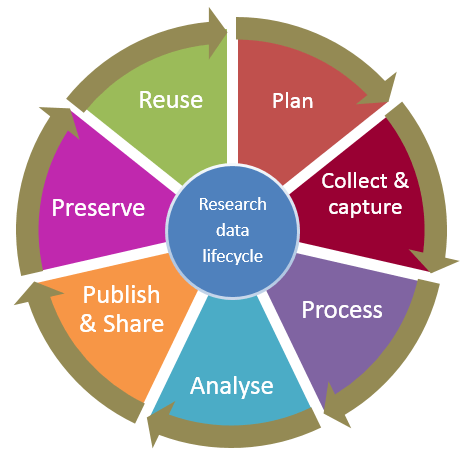
Welcome to the section on Research Data Management.
Planning how you will manage your research data in advance means you can maximise its impact and reuse.
This guide will cover the basic of data management and its benefits.
Research Data refers to the information, records, and files that are collected or used during the research process. This data may be digital or non-digital, and collected through a variety of means including experiments, observations, and tests. Some examples of research data include:
Research data does not include the end results of research such as published articles, or literature reviews or references.
For all types of data you are collecting, you will need to think about how you will preserve the data and control who has access to it during and after your research. This may affect the data collection (e.g. you may need to get consent from research participants).
Before you start collecting data ensure the following:
A Data Management Plan (DMP) may include:
Many Australian universities have data management policies, procedures, and tools available for researchers who need to create a DMP at the start of a research project.
See the Digital Curation Centre's DMPOnline tool for more information.
Creating a research data management plan at the start of the research project will help save time in the:
of data.
Effective data management means you can:
This is important as grant and funding bodies will require research data to be managed throughout its lifecyle (see below). You may need to provide the data or information about the data in order to publish your research, for example.

Research Data Lifecycle. Adapted from UK Data Service Model 2017. Queensland University of Technology, Advanced Information Research Skills . CC BY-NC-SA 4.0
The FAIR and CARE principles are frameworks that guide data management. They ensure that your research data maximises its impact, and is respectful to the people and purpose behind the data.
FAIR
The FAIR principle requires data to be:
It is a framework for sharing data in a way that maximises its use and reuse. See the Making Data FAIR page at the ARDC for more information on the FAIR principles and how to apply them.
CARE
If your research involves the handling, management, and/or analysis of Indigenous data, you should consider applying the CARE Principles for Indigenous Data Governance.
CARE:
For more information about the CARE principles and how to apply them, see the CARE Principles page at the ARDC.
The FAIR and CARE principles are complementary: FAIR ensures that the data is easier to share and reuse, CARE ensures that the data is used ethically.
Security and storage of your data is vital. See below for some basic advice. Be aware that funding institutions may have specific requirements for the storage of your research data
For digital data:
For non-digital data:
It is essential to come up with a plan in advance and implement it for how you will document and describe your project and your data. Information about data (e.g. dates, descriptions, titles) is called metadata. Metadata is essential for enabling your data to be found and used. You may like to begin by thinking about how you would describe the data you have obtained and how it was obtained.
Common information included in metadata:
Try and be consistent with information like filenames as this will allow for easy retrieval of your data in the future.
Some data repositories have the ability to generate and assign unique identifiers to data (such as DOIs), which can help with citing, finding, and reusing of data.
Publishing data
When you have completed your research, the publisher, funder or your institution may require you to publish a final version of your data. This can be to verify the findings in your article or to enable reuse by other researchers that want to build on your findings. Reasons why you would want to publish your data include:
Publishing in a data repository is a common way to achieve this. Data repositories are specifically designed for collecting, storing, managing, archiving and providing access to data in a way that allows other researchers to verify your work and build on their own using your data.
There are 2 kinds of repositories related to research: institutional and data
Consideration factors
When deciding on a data repository, consider:
Choosing a repository
Below are some examples of data repositories, and places to find repositories:
You might want to consider how trusted the repository is and use the TRUST principles to make your decision. You can also consult the Digital Curation Centre's Checklist for help evaluating repositories